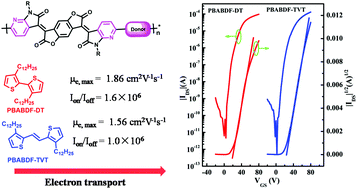Bis(2-oxo-7-azaindolin-3-ylidene)benzodifuran-dione-based donor–acceptor polymers for high-performance n-type field-effect transistors†
Abstract
Two donor–acceptor (D–A) conjugated polymers, PBABDF-DT and PBABDF-TVT, were synthesized using a strongly electron-deficient unit, (3E,7E)-3,7-bis(6-bromo-1-(4-decyltetradecyl)-2-oxo-7-azaindolin-3-ylidene)benzo[1,2-b:4,5-b′]difuran-2,6(3H,7H)-dione (BABDF) as the acceptor, and dithiophene and (E)-2-(2-(thiophen-2-yl)vinyl)thiophene as the donor units. Both polymers exhibited low LUMO energy levels (∼−4.0 eV) for marching with electron transport and displayed excellent n-type charge transport characteristics. The organic field-effect transistors exhibited the highest electron mobilities of 1.86 cm2 V−1 s−1 and 1.56 cm2 V−1 s−1 with high Ion/Ioff ratios of 1.6 × 106 and 1.0 × 106 for PBABDF-DT and PBABDF-TVT, respectively. Both polymers had highly uniform polymer nanofibers, orderly lamellar crystalline structures, and close π–π stacking distances which all contributed to the high charge carrier mobility.



 Please wait while we load your content...
Please wait while we load your content...